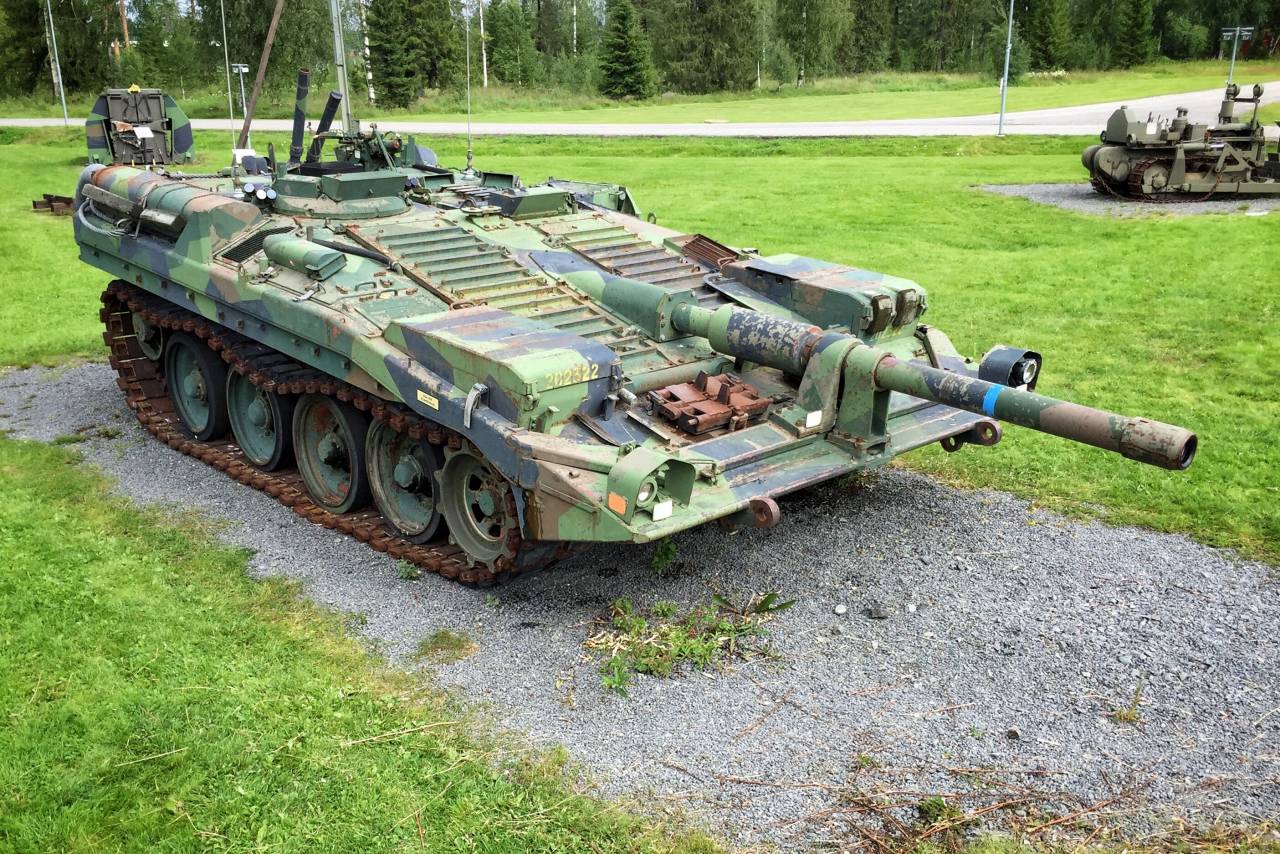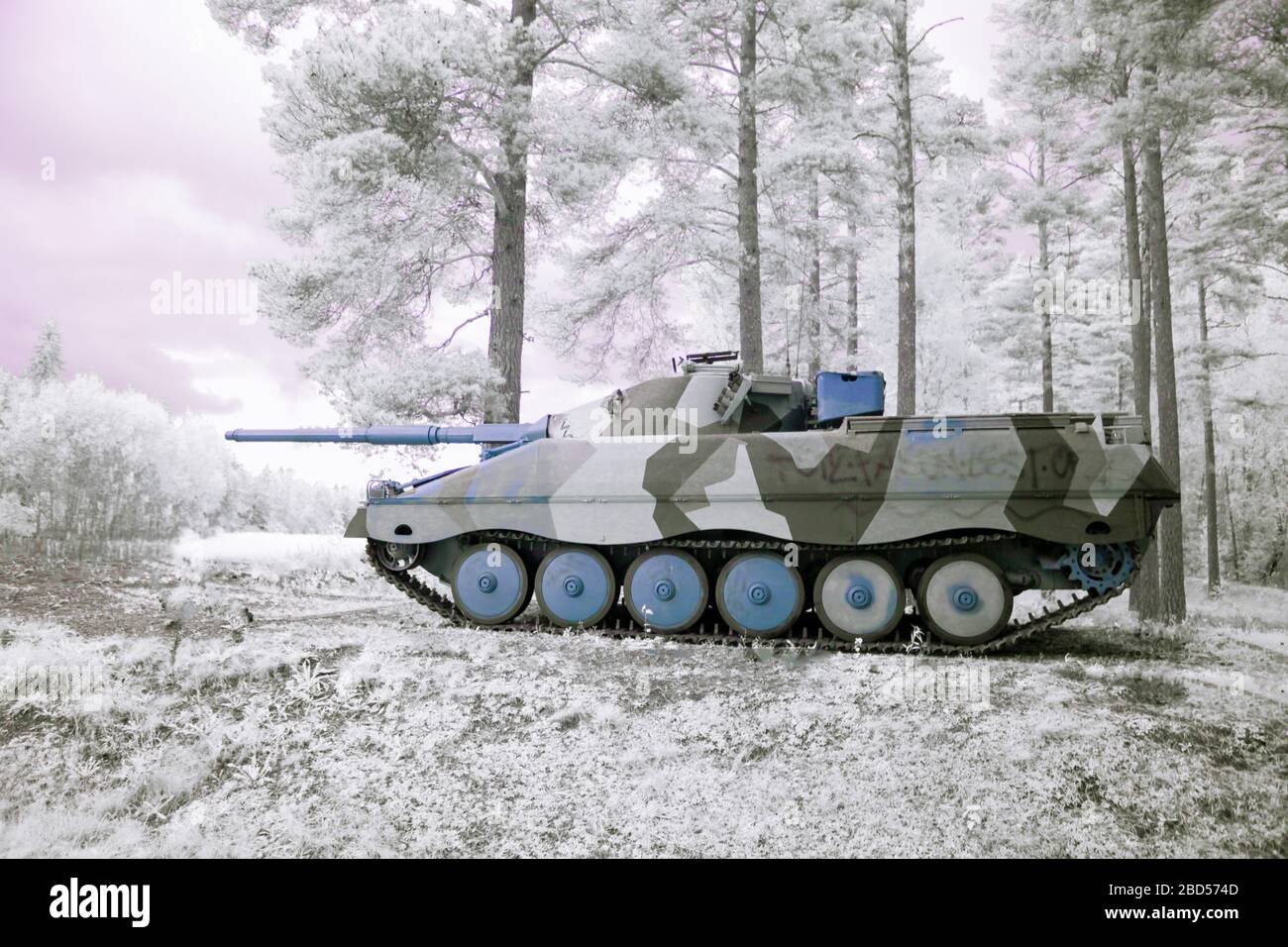Swedish Tank Destroyers - "Strv" is the Swedish military abbreviation for Stridsvagn, Swedish for wagon and tank (literally war vehicle), while the 103 comes from being the third tank in Swedish service armed with a 10cm gun.
Developed in the 1950s, it was the first main battle tank to use the gas turbine engine and the only mass-produced tank since World War II to deploy a turret apart from the German Kanonjagdpanzer.
Swedish Tank Destroyers

It is turretless with a fixed gun with which the tracks are gauged (like the 75mm gun on the 1930 Frch Char B1) and raised by adjusting the hull suspension.
Bae Systems Unveils New Cv90 Variants For Swedish Army
The result was a very low profile design with an emphasis on survivability and high levels of crew protection. Strv 103s formed the bulk of the Swedish armored forces from the 1960s to the 1990s, when they, along with the Cturions, were replaced by the Leopard 2 variants Stridsvagn 121 and Stridsvagn 122.
While most turretless armored fighting vehicles are classified as assault guns or tank destroyers, the Strv 103 is considered a tank because its designated combat role matches other tanks within contemporary Swedish doctrine. .
In the mid-1950s, the Royal Swedish Army's Materiel Administration was contracted to design the next generation tank to replace its Cturions.
A consortium of Landsverk, Volvo and Bofors responded with a proposal to revive an older domestic heavy tank design, codenamed KRV, with a 155mm smoothbore gun. However, this scheme was considered too hollow compared to the alternative: A ("Anglo-American"), which would have to purchase a 50-ton tank with high protection and modest mobility from Britain or the United States. Or the alternative T ("German-French", or "German-French") was a 30-ton tank with less protection and better mobility. In 1956, Sv Berge of the Swedish Arms Administration proposed Alternative S, a national alternative ("S" stands for "Swedish").
Development] Swedish Ground Vehicles: U Sh 405
Studies of casualty reports from World War II and the Korean War revealed that the risk of being killed in combat was strongly related to altitude, with more than half of tank losses resulting from turret hits. Bridge therefore concluded that any new design should be as minimal as possible.
The basic solution was to remove the turret, which would also eliminate a vulnerable target area and make the tank much easier. In terms of absolute height, the final design did not give the Strv 103 a significant advantage over its potential opponent, the T-62. The latter was slightly taller with a height of 2.20 m (7 ft 3 in) and a turret compared to the Strv 103's 2.14 m (7 ft 0 in). On the other hand, the Swedish Cturions towered over the two with their 2.94 m (9 ft 8 in) - 3.01 m (9 ft 11 in) in height. However, the T-62 paid for its low profile with an extremely cramped interior and lack of weapons. Tanks are often deployed in low-hill firing positions, either behind a dug-out truck or using the top of a hill, to prevent vehicular fire. In this firing position, the exposure level is determined by the distance between the bottom of the gun barrel and the top of the turret or carriage, and the angle at which the carriage is able to depress the gun barrel. Because the Strv 103 protrudes from the deck tank to suppress and raise the barrel, it has a very low apparent height in the hull-down position and subsequent visual profile for Amy. It can also lower the fuselage by an additional 13 cm (5.1 in) by adjusting the suspension.
Knowing both the precision transmission of the French Char B1, the exceptional turning performance of short-track guns, and the combat performance of the German StuG and Jagdpanzer series, the turret design solved the targeting problem by using a fully automatic transmission. to do. A suspension system which precisely rotated and tilted the tank under the gunner's control. The gun itself will be attached to the hull.

This made it impossible to use a fixed gun. As a result, the tank could not move and fire accurately at the same time, but Swedish experience with the Cturions suggested that for tanks to achieve acceptable accuracy, they still had to stop, and in the wrong way.
Wot St: Latta Stridsfordon
Other features of the tank were also quite radical. The rifled gun, a Bofors 105 mm L74 with a barrel of LG 62 caliber, was capable of using the same ammunition as the British Royal Ordnance L7, and would be equipped with an autoloader capable of firing a round every three seconds. Also allows allows staff to be reduced to two; A gunner/driver and commander (most designs of the era used a crew of four), with one man handling all tank functions from a common position due to dual controls. This would of course only be used in an emergency as the workload would be heavy, but in addition to providing redundancy it also allowed staff to shift tasks between them as needed. This concept was put through practical tests, which quickly revealed that a two-man crew would not be self-sufficient considering many tasks not directly related to handling the tank: In particular, routine maintenance, Biowalking, track changes and reloading in the field. . Although the latter problem could be solved by adding an ammunition crew, it was decided that a third crew member was needed. To increase combat effectiveness, a third man had to be assigned as the rear driver/radio operator, who had to face the rear of the tank and be equipped with a full driving setup. This allowed the tank to be driven backwards at forward speed, with its frontal armor aimed at the Amy, relieving the commander of routine radio duties. Both the commander and the gunner/driver had the same means of aiming and controls for firing the gun and maneuvering the tank.
The tank was uniquely powered by two different types of engines, a 240 horsepower (180 kW) Rolls-Royce K60 opposed-piston diesel for slow cruising and on-target maneuvering, and an additional turbocharged 300 horsepower (220 kW) Boeing 502. Power, that drive at high speeds or over rough terrain. The turbine soon proved underpowered and was replaced with a Caterpillar turbine delivering 490 horsepower (370 kW) after more than 70 tanks had not been produced and all previous vehicles had been remanufactured. This was the first use of a turbine engine in a production tank. The Soviet T-80 and the American M1 Abrams would later be built with gas turbines for main propulsion. The concept was interesting enough that Bofors was asked to build a prototype of the suspension/drive train, which they successfully completed.
Strv 103 was fully afloat. A float disc can be erected around the upper hull in about 20 minutes, and the tracks will propel the tank through the water at a speed of about 6 km/h (3.7 mph).
One tank in each platoon was fitted with a dozer blade under the front, which was manually dropped from the outside of the tank and locked in working position with pins and outriggers. The wing allowed him to perform simple gendarme tasks, such as digging fire pits for platoons, filling trenches to facilitate passage, etc. When the job was done, the blade was again manually returned to position under the front hole and locked into place. All tanks were fitted with a bulldozer blade when the 103C model was introduced, both to speed up operation and to protect the bottom.
Swedish S Tank Strv 103c 1/35 Trumpeter
In preparing the Defense Plan of 1958 (Försvarsbeslut 1958 (FB58)) in the Riksdagen (Swedish Riksdag), the Procurement Committee pitted Alternative S against two foreign alternatives, Alternative A and Alternative T. The Defense Committee's report recommended that "S" weigh the symbolic value of a household tank to a neutral country as well as derivative effects on Swedish industrial capacity.
The Reichstag formally approved the FB58 on 4 February 1958, and a follow-on contract called for two production prototypes, which were completed in 1961. By this time, the Army was satisfied enough with the design to place an initial pre-production order for it. 10 was placed in 1960.
With minor changes, the Alternativ S was adopted as the Stridsvagn 103 ("103" being the third tank accepted into Swedish service with a 10 cm caliber gun). Full production began in 1967 and 290 were delivered in 1971. Changes included a new gyro-stabilized commander's cupola armed with a 7.62 mm SP-58 machine gun and upgraded frontal armor. A unique slotted armor grill can be fitted to the front to defeat High Explosive Anti-Tank (HEAT) rounds. However, it was kept secret for many years and was only to be installed in case of war.

Despite its design, the Strv 103 was built for offensive operations. The Swedish Army's armored brigades, which operated Strv 103, were designated Enphalesbrigader (Assault Brigade) and tasked with launching counterattacks.
Swedish Tank Destroyer Revealed In Supertest
American tank destroyers, british tank destroyers, tank destroyers, british ww2 tank destroyers, us army tank destroyers, tank destroyers wwii, tank destroyers ww2, swedish destroyers, world war 2 tank destroyers, german tank destroyers, elefant tank destroyers, ww2 american tank destroyers
0 Comments